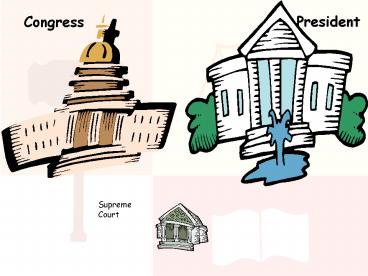Congress - PowerPoint PPT Presentation
1 / 36
Title:
Congress
Description:
President Congress Supreme Court – PowerPoint PPT presentation
Number of Views:109
Avg rating:3.0/5.0
Title: Congress
1
President
Congress
Supreme Court
2
Supreme Court Cases
Landmark Supreme Court cases that outlined the
powers of the Judicial Branch
3
Oyez! Oyez! Oyez! (pronounced o-yea) All
persons having business before the Honorable, the
Supreme Court of the United States, are
admonished to draw near and give their attention
for the Court is now sitting. God save the
United States and this Honorable Court!
4
Case 1
Marbury v. Madison
5
The Plaintiff William Marbury
The Judge Chief Justice John Marshall
The Defendant James Madison
6
The Case
John Adams lost to Thomas Jefferson in the
Election of 1800.
John Adams
Thomas Jefferson
Before leaving office, Adams appointed his
Secretary of State, John Marshall, to Chief
Justice of the Supreme Court. He also appointed
42 other Federalists to judiciary positions using
the Judiciary Act of 1801.
7
Before taking the judgeship, John Marshall was to
deliver (informs) the 42 new judges of their
appointments. He was able to deliver only 17.
He assumed his successor, James Madison would
deliver the rest.
James Madison
8
James Madison was the new secretary of state, and
President Jefferson told him not to deliver the
appointments.
William Marbury, appointee to Justice of the Peace
William Marbury, an appointee, filed suit against
James Madison because he did not get his
appointment.
Youre a judge
9
The Issue
What are the powers of the Supreme Court,
especially when making decisions about the
Constitution?
10
The Decision
Chief Justice John Marshall, declared that
Madison should have delivered the appointment to
Marbury, but the Court also argued that the
Judiciary Act which Marbury used to force his
appointment was unconstitutional.
11
Constitutional Significance
1. Judicial Review The case established the
Supreme Courts right to review acts of the
President and Congress and declare them
unconstitutional.
12
2. The Supreme Court became the final authority
on what the Constitution really means.
In Marshalls own words
The Constitution is the supreme law of the land.
It is emphatically the duty of the judicial
department to say what the law is.
13
3. Judicial review made the Supreme Court an
equal partner in the United States government and
an essential player in the system of checks and
balances.
14
Case 2
McCulloch v. Maryland
15
The Plaintiff James McCulloch
The Judge Chief Justice John Marshall
The Defendant the state of Maryland
16
Many people opposed the constitutionality of the
Bank of the U.S.
No more bank
State banks said the creation of the national
banks presented unfair competition.
In an effort to help state banks, Maryland issued
a tax on the U.S. Bank of Baltimore.
17
The chief cashier of the Bank of the U.S., James
McCulloch, refused to pay the tax.
Maryland took McCulloch to court in the state
court, and the ruling was that McCulloch had to
pay the tax. McColloch appealed to the Supreme
Court.
18
The Decision
The Supreme Court ruled in favor of McColloch and
the national government.
19
The Issue
Bank of the U.S.
Does the federal government have the power to
create Congress-chartered institutions such as
the Bank of the United States?
20
Constitutional Significance
1. Chief Justice Marshall and the Court ruled
that the national government (Congress) did have
the authority to create the national
bank.necessary and proper clause .
21
- The power of the national government was
strengthened. Established the supremacy of
federal law and the ability of Congress to
exercise powers needed to carry out its duties
22
Case 3
Gibbons v. Ogden
23
The Plaintiff Aaron Ogden
The Judge Chief Justice John Marshall
The Defendant Thomas Gibbons
24
Aaron Ogden was a licensed steamboat operator who
had a monopoly (exclusive control) on steamboat
operations between New York and New Jersey.
Gibbons also operated steamboats between the two
states but did not have a license.
25
Ogden sued Gibbons to keep him from operating his
unlicensed steamboat.
Ogden won, but Gibbons issued an appeal to the
U.S. Supreme Court.
26
Article I of the Constitution gives Congress the
power to regulate commerce with foreign nations,
and among the several States..
27
The Issue
Who should regulate commerce (trade) the states
or the federal government?
28
Constitutional Significance
1. The Supreme Court expanded the meaning of
the definition of commerce to increase the
national governments power to regulate commerce.
29
2. The commerce clause gave the national
government has the authority to control all areas
of economic activity in the United States.
30
John Marshall
Architect of the American constitutional system.
31
Until John Marshall became the 4th Chief Justice
of the Supreme Court, the Court was seen as
having little power, with almost no influence
over the other two branches.
President
Congress
Supreme Court
32
In a series of brilliant decisions from
1800-1835, Marshall almost single-handedly gave
new power to the Constitution.
33
Marshall established three basic principles that
became the foundation of the federal union.
1. The principle of judicial review gave the
Supreme Court power to determine if a law was
unconstitutional.
34
2. The Supreme Court had the power to set aside
laws of state legislatures when these laws were
contrary to the federal Constitution.
3. The Supreme Court had the power to reverse
the decisions of state courts.
35
Marshall argued that it is necessary for those
interpreting and living under the Constitution to
treat it as a living document that can be
accommodated to the changing needs of the
American peopleLoose construction .
36
CLOSING QUESTION
How did Marshall embrace the concept of the
Constitution as a living document?































